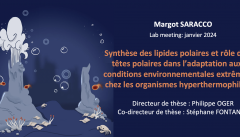
Soutenance de doctorat de Margot Saracco (Equipe M2E)
Mutants? What Mutants? Deciphering the relative contribution of polar lipids in the adaptation to extreme environmental conditions in the Hyperthermophilic Thermococcales Pyrococcus furiosus.
Polar lipids, the key stone of hyperthermophilic Archaea membrane stability
Among the three domains of life, Archaea are distinguished by the unique structure of their membrane lipids, which feature polyisoprenoid ether-linked chains in a sn-2,3 configuration, unlike the ester-linked fatty acids in Bacteria and Eukarya. These distinct features are acknowledged as key components of archaeal membrane adaptations, enabling them to thrive under extreme conditions such as high temperature, salinity, and acidity. Despite their importance, the diversity and biosynthetic pathways of archaeal polar lipids remain poorly understood.
This thesis investigates membrane organization and lipid remodeling in the hyperthermophilic archaeon Pyrococcus furiosus. Historically, its membrane was thought to be dominated by phosphatidylinositol-diether (PI-DGD). However, by combining a genetic approach with advanced lipidomic analyses, it was demonstrated that PI-DGD, contrary to previous assumptions, is only a minor component of P. furiosus membrane. Instead, two other phosphatidylhexose diethers, phosphatidylglucose (PGlc-DGD) and phosphatidylmannose, were detected, with PGlc-DGD emerging as the dominant polar lipid. These findings call into question historical lipid annotations and highlight the misannotation of genes hypothetically involved in PI-DGD synthesis, emphasising the importance of enzymatic validation for gene function assignments.
The genetic approach, through the construction of P. furiosus deletion mutants, also led to the partial disruption of PGlc-DGD biosynthetic pathways. This enabled the identification of five previously undescribed tetraether lipids bearing glycosylated or N-acetylated head groups. Additionally, a novel lipid structure, referred to as a hexaether, was detected, featuring an unprecedented combination of diether and tetraether moieties. The known lipid repertoire of P. furiosus now includes at least seven diether and eleven tetraether structures. Considering variations in unsaturation, cyclopentane ring content, and head group composition, this archaeon likely produces over 300 distinct lipid species, a level of complexity approaching that of eukaryotic systems.
To assess the physiological relevance of this lipid diversity in the context of environmental stress adaptation, both in vivo and in vitro approaches were employed. Under cold or high-salinity conditions, P. furiosus remodels both its isoprenoid chains and polar head groups. Notably, changes in tetraether ring content and diether saturation were observed, while the proportion of diether lipids remained constant at 10 % across all conditions, an uncommon feature among Thermococcales. To explore the functional importance of this stable ratio, archaeal-like membranes with varying diether/tetraether compositions were constructed and analyzed using neutron diffraction. Membranes containing both lipid classes demonstrated enhanced structural organization and thermal stability compared to those composed of a single lipid type, suggesting that the interplay between flexible diethers and rigid tetraethers is crucial for membrane robustness.
In addition to the isoprenoid core structure, polar head groups were shown to play a significant role in membrane behavior. N-acetylation of hexose head groups appeared to enhance membrane stability, and even subtle shifts in sugar composition, from mannose to glucose, were found to influence membrane properties, likely due to differences in hydrogen-bonding capacity. These findings suggest that polar head group chemistry is a critical but previously underappreciated factor in archaeal membrane adaptation. In conclusion, this thesis demonstrates that lipid diversity is central to membrane adaptability in Archaea. Polar head groups, in particular, contribute significantly to membrane structure, fluidity, and resilience. This research provides a foundation for future biochemical and biophysical studies and opens new perspectives for the development of bioinspired membranes in synthetic biology.
Informations complémentaires
- margot.saracco@insa-lyon.fr
- https://map.insa-lyon.fr/fr/content/microbiologie-environnements-extremes
-
Amphithéatre Marie Curie, INSA Lyon

